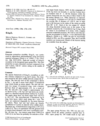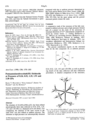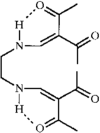issue contents
October 1998 issue

Cover illustration: An Adduct Between Tetraammine(1,10-phenanthroline)ruthenium(II) and Dibenzo-42-crown-14, see Yoon et al., pages 1427-1431. The hydrogen bonding of the ammine ligands with the crown O atoms is shown with displacement ellipsoids plotted at the 30% probability level. Non-ammine H atoms have been omitted for clarity.
cif-access (metal-organic compounds)
Download citation


Download citation


The title complex consists of infinite positively charged [Sc2(Gly)6]n (Gly = glycine) chains and ClO4− anions. The Sc3+ ions in the [Sc2(Gly)6]n chains are linked by glycine molecules and are octahedrally coordinated by glycine O atoms.
Download citation


Download citation


This compound belongs to a family of dimeric clusters formed through bonding of electron-rich iron carbonyls to electron-deficient thallium. Pressurization under CO of the thallium-iron carbonyl [Et4N]2[Fe4Tl2(CO)16] yielded crystals of [Et4N]2[Fe6Tl2(CO)24], which crystallizes in the orthorhombic centrosymmetric space group Cmca.
cif-access (organic compounds)
Download citation


Download citation


The crystal structure of 2-pyridinecarboxylic acid was redetermined to confirm the space group C2/c. However, a solid-state high resolution 15N CP-MAS NMR study indicated that neutral molecules and zwitterions are arranged alternately within local non-centrosymmetric domains.
Download citation


Download citation


On short-term heating, highly strained ap-9-(o-tert-butylphenyl)-9-(methylthio)fluorene underwent facile cleavage of the C-S bond. Migration of the methylthio group produced sp-9-(o-tert-butylphenyl)-3-(methylthio)fluorene as the major product. Its structure is much less distorted than that of the ap starting material.
Download citation


Download citation


The title compound crystallizes with two independent molecules per asymmetric unit. The molecules assume slightly different conformations. The crystallographically unique molecules stack in columns along the b axis. Close C-H⋯O contacts are observed between molecules related by a twofold screw axis. The absolute configuration was established by internal comparison with the (R)-(−)-O-methyl mandelic acid moiety.
inorganic compounds
Download citation


Download citation


Disodium zinc diphosphate may be doped with europium(III) to produce a red-emitting material, Na1.94Eu0.02ZnP2O7. Determination of the single-crystal X-ray structures of the doped and undoped forms shows them to be isostructural, with EuIII occupying a site of mm symmetry.
Download citation


Download citation


KAg5S3 contains a combination of linear and trigonal planar coordination of Ag by S atoms, resulting in a channeled framework filled with K+ cations.
Download citation


Download citation


The structure of [Co(NO2)(NH3)5]Cl2 has been refined anisotropically from data collected at 0.24, 0.52, 1.25, 1.91 and 3.38 GPa in a diamond anvil cell. For comparison, the structure of the same crystal in the same diamond anvil cell was also refined at ambient pressure.
Download citation


Download citation


This new ammonium zinc phosphate, which is isostructural with KZn2(PO4)(HPO4), consists of corrugated anionic layers of ZnO4 and PO4 tetrahedra sharing vertices. Trigonally coordinated O atoms are present in these layers.
metal-organic compounds
Download citation


Download citation


Download citation


Download citation


Download citation


Download citation


Download citation


Download citation


Download citation


Download citation


Download citation


Download citation


Download citation


Download citation


Download citation


Download citation


Download citation


Download citation


Download citation


Download citation


Download citation


Download citation


Download citation


Download citation


Download citation


Download citation


Download citation


Download citation


Download citation


Download citation


Download citation


Download citation


Download citation


Download citation


Download citation


Download citation


Download citation


Download citation


Download citation


Download citation


Download citation


Download citation


Download citation


Download citation


Download citation


Download citation


Download citation


Download citation


organic compounds
Download citation


Download citation


Download citation


Download citation


Download citation


Download citation


Download citation


Download citation


Download citation


Download citation


Download citation


Download citation


Download citation


Download citation


Download citation


Download citation


Download citation


Download citation


Download citation


Download citation


Download citation


Download citation


Download citation


Download citation


Download citation


Download citation


Download citation


Download citation


Download citation


Download citation


Download citation


Download citation


Download citation


Download citation


Download citation


Download citation


Download citation


Download citation


Download citation


Download citation


Download citation


Download citation


Download citation


Download citation


Download citation


Download citation


Download citation


Download citation


Download citation


Download citation


Download citation


Download citation


Download citation


Download citation


Download citation


Download citation


Download citation


Download citation


Download citation


Download citation


Download citation


Download citation


Download citation


Download citation


Download citation


Download citation


Download citation


Download citation


Download citation


Download citation


Download citation


Download citation


Download citation


Download citation


Download citation


Download citation


Download citation


Download citation


Download citation


Download citation


Download citation


Download citation


Download citation


Download citation


Download citation


Download citation


Download citation


Download citation


Download citation


Download citation




 journal menu
journal menu































































































